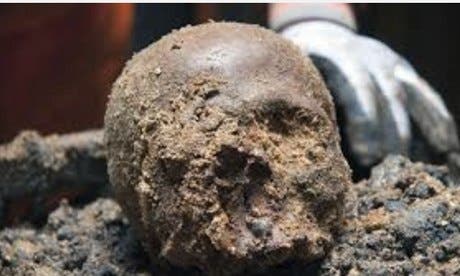
Using modern forensic techniques, bioarchaeologists have found that a slew of skulls, discovered a few decades ago in an ancient open pit in nowadays London, not too far from a known amphitheater site, bear evidence that speak of gruesome decapitation at the hands of Roman headhunters. The findings provide the first evidence of such Roman practice in Britain.
Roman headhunters
Some 39 skulls were excavated at the London Wall almost within sight of the Museum of London in 1988. At the time, not much thought was given to them and have remained in the possession of the museum since. Using refined forensic techniques, scientists found that these skulls weren’t just some dismembered remains belonging to an ancient graveyard. Instead, the skulls tell a different story – one of fear, gore and death by beheading.
“It is not a pretty picture,” Rebecca Redfern, from the centre for human bioarchaeology at the museum of London, said. “At least one of the skulls shows evidence of being chewed at by dogs, so it was still fleshed when it was lying in the open.”
“They come from a peculiar area by the Walbrook stream, which was a site for burials and a centre of ritual activity – but also very much in use for more mundane pursuits. We have evidence of lots of shoe making, so you have to think of the cobbler working yards from these open pits, with the dog chewing away – really not nice.”
“We believe that some of the heads may be people who were killed in the amphitheatre. Decapitation was a way of finishing off gladiators, but not everyone who died in the Roman amphitheatre was a gladiator, it was where common criminals were executed, or sometimes for entertainment you’d give two of them swords and have them kill one another. Other heads may have been brought back by soldiers from skirmishes, probably on the Hadrian or Antonine walls – again, it would have taken weeks to bring them back, so not a nice process.”
Almost all skulls are of adult males, and all bear signs of violence – scars, slash marks, shattered facial bones. On some there is clear evidence of decapitation with a sword, and quite possibly all of them might have been killed this way, but there’s no way of telling for sure if the fatal blow struck the neck.
“Whether they died in the amphitheatre or in battle, decapitation with a sword is a very efficient way of ending a life – somebody very much wanted these people dead,” Redfern said.
Gruesome warning to the enemies of Rome
What’s really startling is that all these beheaded skulls were left in the open, out in open pits to decompose for god knows how long.
“There is none of the fracturing you’d expect if they’d been put on spikes, so it looks as if they were just set down and left – though of course you could have had a nice shelf to display them on.”
Evidence of Roman headhunters has been found throughout the old Roman Empire, including portrayals of the practice in monuments like Trajan’s column in Rome which shows clean shaven Roman soldiers presenting bearded barbarian heads as trophies to the emperor. Hundreds of skulls have been found for centuries along the course of the long vanished Walbrook. These have been labeled as remnants from washout cemeteries or the victims of native uprisings in 60 AD when Boudicca, Anglican leader of the Icenii tribe, swept south to London and attacked Roman settlements. These latest findings suggest that not is how it seems, and the hundreds of skulls discovered in the area may have also shared this twisted, and unfortunate fate.
“These were all young men, very untypical of what we usually find in Roman burials, where we tend to get the very young and the old,” Redfern said.
“Most people in second century London lived peaceful quiet lives – but as we now know, not everyone. This is a glimpse into the very dark side of Roman life.






